Plus Two Zoology Notes Chapter 6 Human Health and Disease is part of Plus Two Zoology Notes. Here we have given Plus Two Zoology Notes Chapter 6 Human Health and Disease.
| Board | SCERT, Kerala |
| Text Book | NCERT Based |
| Class | Plus Two |
| Subject | Zoology Notes |
| Chapter | Chapter 6 |
| Chapter Name | Human Health and Disease |
| Category | Plus Two Kerala |
Kerala Plus Two Zoology Notes Chapter 6 Human Health and Disease
Common Diseases In Humans
The major disease-causing organisms( pathogens) are bacteria, viruses, fungi, protozoans, helminths, etc.
Typhoid (caused by the bacterium Salmonella typhi)
These pathogens enter the small intestine through the contaminated food and water and migrate to other organs through blood. High fever (39° to 40°C), weakness, stomach pain, constipation, headache and loss of appetite are the common symptoms of this disease.
Typhoid fever is confirmed by the Widal test.
Pneumonia (caused by the bacterium Streptococcus pneumoniae and Haemophilus influenza)
After the infection the alveoli filled with fluid and leads to problems in respiration. Symptoms are Fever, chills, cough, headache, the lips and finger nails turn gray to bluish colour, etc.
Dysentery, plague, diphtheria, etc., are some of the other bacterial diseases in man.
Common cold (caused by the Rhino viruses)
They infect the nose and respiratory passage but not the lungs. Symptoms are nasal congestion and discharge, sore throat, hoarseness, cough, headache, tiredness, etc., which usually last for 3 – 7 days.
Malaria (caused by the protozoa called Plasmodium vivax, P. malaria and P. falciparum-causes fatal malaria)
Stages in the life cycle of plasmodium:
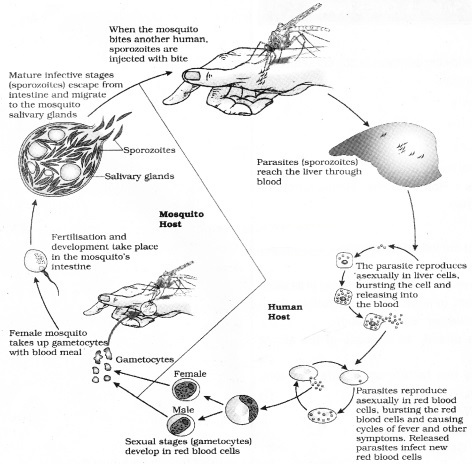
The malarial parasite requires two hosts – human and mosquitoes (vector)-to complete its life cycle. Plasmodium enters the human body as sporozoites (infectious form) through female Anopheles mosquito.
The parasites multiply within the liver cells and attack the red blood cells (RB0s) resulting in their rupture. The ruptured RBCs release of a toxic substance, haemozoin, which is responsible for the chill and high fever for three to four days.
When a female Anopheles mosquito bites an infected person, these parasites enterthe mosquito’s body and undergo further development.
The parasites multiply within them to form sporozoites that are stored in their salivary glands. When these mosquitoes bite a human, the sporozoites enters into the body and causes the symptoms of the disease.
Amoebiasis (amoebic dysentery)
It is caused by protozoan parasite Entamoeba histolytica in the large intestine of human. Symptoms are constipation, abdominal pain and cramps, stools with excess mucous and blood clots.
Houseflies transmit the parasite from faeces of infected person to food and food products, thereby contaminating them.
Drinking water and food contaminated by the faecal matter are the main source of infection.
Ascariasis
It is caused by the round worm Ascaris, (intestinal parasite). Symptoms of these disease include internal bleeding, muscular pain, fever, anemia and blockage of the intestinal passage.
The eggs of the parasite are excreted along with the faeces of infected persons which contaminate soil, water, plants, etc.
A healthy person get infection through contaminated water, vegetables, fruits, etc.
Elephantiasis (filariasis)
The filarial worm Wuchereria (W. bancrofit and W. malayi), causes the swelling of the lymphatic vessels of the lower limbs.

The pathogens are transmitted to a healthy person through the bite by the female mosquito vectors.
The fungi Microsporum, Trichophyton and Epidermophyton are responsible for ringworms which is one of the most common infectious diseases in man.
Symptoms are dry, scaly lesions on skin, nails and scalp, etc. These lesions are accompanied by intense itching.
Ringworms are acquired from soil or by using towels, clothes or even the comb of infected individuals.
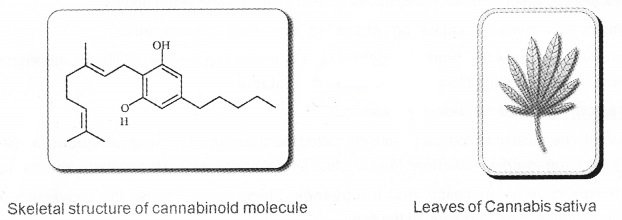
Introduction of fishes like Gambusia in ponds that feeds mosquito larvae, spraying of insecticides in ditches, drainage areas and swamps, etc. are the method adopted to control mosquitoes.
In addition, doors and windows should be provided with wire mesh to prevent the entry of mosquitoes.
The above practice is useful in the case of diseases like dengue and chikungunya. The immunisation programmes are useful to eradicate a deadly disease like smallpox.
A large number of other infectious diseases like polio, diphtheria, pneumonia and tetanus have been controlled by the use of vaccines.
Immunity
It is the ability of the host to fight the disease-causing organisms .
Immunity is of two types:
- Innate immunity and
- Acquired immunity.
1. Innate Immunity:
It is the non-specific type of defence, that is present at the time of birth. Innate immunity consist of fourtypes of barriers.
(i) Physical barriers:
Skin isthe main barrierwhich prevents entry ofthe micro-organisms. Mucus coating of the epithelium lining the respiratory, gastrointestinal and urogenital tracts also help in trapping microbes entering our body.
(ii) Physiological barriers:
Acid in the stomach, saliva in the mouth, tears from eyes prevent the microbial growth.
(iii) Cellular barriers:
The leukocytes (WBC) like polymorpho-nuclear leukocytes (PMNL-neutrophils) and monocytes in the blood as well as macrophages in tissues can phagocytose and destroy microbes.
(iv) Cytokine barriers:
Virus-infected cells secrete proteins called interferons which protect non-infected cells from further viral infection.
2. Acquired Immunity:
It is pathogen-specific and based on memory. The Antigen binding site body meets a pathogen for the first time produces a response called primary response.
If the same pathogen attacks second time, it possess the memory of the first encounter.
The primary and secondary immune responses are carried out by B-lymphocytes and T-lymphocytes. in the blood.
The B-lymphocytes produce an army of proteins they are called antibodies. But the T-cells do not secrete Heavy chain antibodies.
Each antibody molecule has four peptide chains, two small called light chains, and two longer called heavy chains. Antibody is represented as H2L2.
Different types of antibodies are:
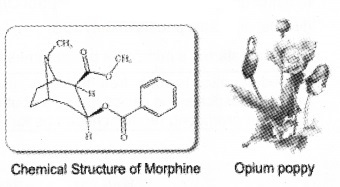
IgA, IgM, IgE, and IgG. The response of these antibodies are called as humoral immune response.
Another type of immune response is called cell-mediated immunity (CMI) Eg-T-lymphocytes
After the transplantation of heart, eye, liver and kidney, the place of grafts shows rejection if not confirming matching of tissues and blood group. Here the cell-mediated immune response is responsible for the graft rejection.
3. Active and Passive Immunity:
When the antigens are coming in the form of living ordead microbes or other proteins, the body of organism produce antibodies .This type of immunity is called active immunity.
When ready-made antibodies are directly injected to protect the body against foreign agents, it is called passive immunity.
Examples of passive immunity:
| 1. Initial days of lactation, the yellowish fluid colostrum secreted by the mother contain antibodies. (IgA). |
| 2. Foetus get the antibodies from mother through the placenta during pregnancy. |
4. Vaccination and Immunisation:
In vaccination, antigenic proteins of pathogen or inactivated/weakened pathogen (vaccine) are introduced into the body.
The vaccines produce memory – B and T-cells that recognize the pathogen quickly on subsequent exposure In the case of snakebites, the injection which is given to the patients, contain preformed antibodies against the snake venom. This type of immunisation is called passive immunisation.
Recombinant DNA technology is helpful in the large scale production vaccines for immunisation, e.g., hepatitis B vaccine produced from yeast.
5. Allergies:
The response of the immune system to certain antigens present in the environment is called allergy. It is due to the release of chemicals like histamine and serotonin from the mast cells The antibodies produced to these are of IgE type.
Symptoms of allergic reactions are sneezing, watery eyes, running nose and difficulty in breathing. The use of drugs like anti-histamine, adrenalin and steroids quickly reduce the symptoms of allergy.
6. Auto Immunity:
It is the memory-based immune response that have the ability to differentiate foreign organisms from self cells.
In some cases the body attacks self-cells. This results in damage to the body and is called auto-immune disease. Eg-Rheumatoid arthritis.
7. Immune System in the Body:
The human immune system consists of lymphoid organs, tissues, cells and antibodies. It plays an important role in allergic reactions, auto-immune diseases and organ transplantation.
Lymphoid organs:
These are the organs where origin /maturation and proliferation of lymphocytes occur. The primary lymphoid organs are bone marrow and thymus where immature lymphocytes differentiate.
After maturation the lymphocytes migrate to secondary lymphoid organs like spleen, lymph nodes, tonsils, Peyer’s patches of small intestine and appendix The secondary lymphoid organs are the sites for interaction of lymphocytes with the antigen, which then proliferate to become effector cells.
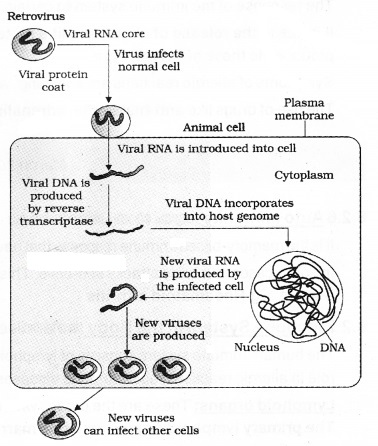
The thymus organ is large at the time of birth but reducing in size with age Both bone-marrow and thymus provide micro-environments forthe developmen and maturation of T-lymphocytes.
The spleen is the reservoir of erythrocytes and contains lymphocytes ant phagocytes. It helps to filter the blood-borne microorganisms.
The lymph nodes are small solid structures helps to trap the micro-organism: or other antigens.
Antigens trapped in the lymph nodes are responsible forthe activation o lymphocytes and cause the immune response.
Lymphoid tissue found in lining of the respiratory, digestive and urogenita. tracts are called mucosal associated lymphoid tissue (MALT).
It constitutes about 50 per cent of the lymphoid tissue in human body.
AIDS (Acquired Immuno Deficiency Syndrome)
AIDS was first reported in 1981 and caused by the Human Immuno deficiency Virus (HIV), It is the category of retrovirus, which possess RNA genome.
Transmission of HIV-infection occurs by
| (a) sexual contact with infected person, (b) by transfusion of contaminated blood and blood products, (c) by sharing infected needles as in the case of intravenous drug abusers (d) from infected mother to her child through placenta. |
Infected cell can survive while viruses are being replicated and released. When the virus enters into macrophages, the RNA genome of the virus replicates to form viral DNA with the help of the enzyme reverse transcriptase. This viral DNA Retrovirus gets incorporated into host cell’s DNA and produce virus particles.
HIV enters into helper T-lymphocytes, replicates and produce progeny viruses. The progeny viruses released in the blood attack other helper T- lymphocytes. The patient becomes immuno- deficient.

Due to the decrease in the number of helper T lymphocytes, the person starts suffering from infections by bacteria especially Mycobacterium, viruses, fungi and even parasites like Toxoplasma.
A widely used diagnostic test for AIDS is enzyme linked immuno-sorbent assay (ELISA).
Prevention of AIDS:
In our country the National AIDS Control Organisation (NACO) and other non-governmental organisation (NGOs) educates people about AIDS.
WHO has started a number of programmes to prevent the spreading of HIV infection.
| Blood donation is done free from HIV, use disposable needles and syringes in public and private hospitals and clinics, free distribution of condoms, controlling drug abuse, advocating safe sex and promoting regular check-ups for HIV in susceptible populations. |
Cancer
In our body, cell growth and differentiation is highly controlled and regulated. In cancer cells, there is breakdown of these regulatory mechanisms.
| Normal cells show a property called contact inhibition -inhibits the uncontrolled growth of cells. But the cancer cells lost this property and give rise to masses of cells called tumors. |
Tumors are of two types: benign and malignant Benign tumors seen in specific location and do not spread to other parts of the body.
Malignant tumors are a mass of proliferating cells called neoplastic or tumor cells. These cells actively divide, grow and starve the normal cells by competing for vital nutrients. Cells from such tumors reach distant sites through blood. This is called metastasis.
Causes of cancer:
It is due to physical, chemical or biological agents are called carcinogens. Ionising radiations like X-rays and gamma rays and non-ionizing radiations like UV cause DNA damage leading to neoplastic transformation.
Oncogenic viruses have genes called viral oncogenes. These viruses cause the conversion proto oncogenes into oncogenic transformation of the cells.
Cancer detection and diagnosis:
Cancer detection is based on biopsy and histo pathological studies of the tissue, blood and bone marrow.
| Techniques like radiography (use of X-rays), CT (computed tomography) and MRI (magnetic resonance imaging) are very useful to detect cancers of the internal organs. |
Early detection of genes is very helpful in the prevention of cancers. Such individuals are advised to avoid exposure to particular carcinogens to which they are susceptible (e.g., tobacco smoke in case of lung cancer).
Treatment of cancer:
In radiotherapy tumor cells are irradiated without damaging the normal tissues. Chemotherapeutic drugs are used to kill cancerous cells. Some of these are specific for particular tumors. Most cancers are treated by combination of surgery, radiotherapy and chemotherapy.
Tumor cells causes the destruction of immune system. Therefore, the patients are given substances called interferon which activate their immune system and help in destroying the tumor.
Drugs And Alcohol Abuse
The drugs, which are commonly abused are opioids, cannabinoids and coca alkaloids.
Opioids are the drugs, its receptors present in our central nervous system and gastrointestinal tract. Heroin (smack) the depressant, is chemically diacetylmorphine which is a white, odourless, bitter crystalline compound.
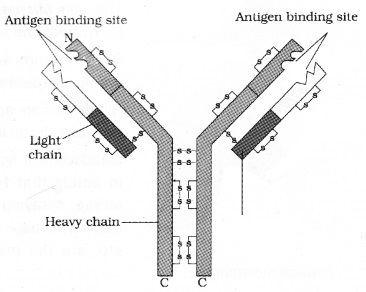
It is prepared by the acetylation of morphine which is extracted from the latex of poppy plant Papaver somniferum.
Cannabinoids are a group of chemicals, its receptors present in the brain. It is obtained from Cannabis sativa.
The flower tops, leaves and resin are used to produce marijuana, hashish, charas and ganja.
cocaine (coke or crack) is obtained from coca plant Erythroxylum coca, native to South America. It affects the transport of the neuro-transmitter dopamine.
It has a stimulating action on central nervous system, producing a sense of euphoria and increased energy. Excessive dosage of cocaine causes hallucinations.
Some plants plants with hallucinogenic properties are Atropa belladona and Datura cannabinoids are abused by some sportspersons.
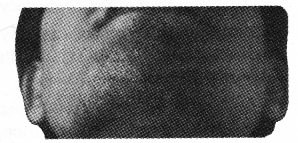
| Drugs -barbiturates, amphetamines, benzodiazepines, and lysergic acid diethyl amides (LSD) | treat mental illnesses like depression and insomnia |
| Morphine | sedative and painkiller is very useful in patients who have undergone surgery. It raise blood pressure and increase heart rate. |
| Tobacco | stimulates adrenal gland to release adrenaline and nor-adrenaline into blood circulation. It raise blood pressure and increase heart rate. |
Flowering branch of Datura:
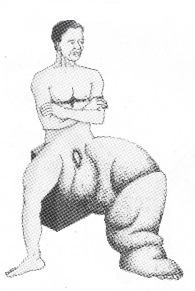
Tobacco chewing increases the risk of cancer of the oral cavity. Smoking also causes cancers of lung, urinary bladder and throat, bronchitis, emphysema, coronary heart disease, gastric ulcer, etc. Smoking increases carbon monoxide (CO) content in blood and causes oxygen deficiency in the body.
1. Adolescence and Drug/Alcohol Abuse:
Adolescence is the period between 12-18 years of age. It is a bridge linking childhood and adulthood. Adolescence is accompanied by several biological and behavioural changes.
| The first use of drugs or alcohol increase the curiosity or experimentation, but later the child starts using these to escape facing problems. If stress from pressures to excel in academics or examinations, has played a significant role in youngsters to try alcohol and drugs. |
2. Addiction and Dependence:
If the repeated use of drugs, the tolerance level of the receptors present in our body increases. So the receptors respond only to higher doses of drugs or alcohol leading to greater intake and addiction. Thus, it leads to their regular use (abuse).
| In the absence of any guidance or counselling, the person gets addicted and becomes dependent on their use. If it is abruptly discontinued , the person shows withdrawal syndrome. This is characterised by anxiety, shakiness, nausea and sweating, etc. |
3. Effects of Drug/Alcohol Abuse:
In youth its symptoms are drop in academic performance, unexplained absence from school/college, lack of interest in personal hygiene, withdrawal, isolation, depression, fatigue, aggressive behaviour, deteriorating relationships with family and friends, loss of interest in hobbies, change in sleeping and eating habits, fluctuations in weight, appetite, etc.
It also cause of mental and financial distress to the family and friends. The direct injection into the vein results the infections like AIDS and hepatitis B.
AIDS transmitted to one’s life partner through sexual contact while Hepatitis B is transmitted through infected blood.
The chronic use of drugs and alcohol damages nervous system and liver (cirrhosis). The use of drugs and alcohol during pregnancy is also known to adversely affect the foetus.
| The side-effects steroids in females include masculinisation, increased aggressiveness, mood swings, depression, abnormal menstrual cycles, excessive hair growth on the face and body, enlargement of clitoris, deepening of voice |
| In males it includes acne, increased aggressiveness, mood swings, depression, reduction of size of the testicles, decreased sperm production, potential for kidney and liver dysfunction, breast enlargement, premature baldness, enlargement of the prostate gland |
4. Prevention and Control:
- Avoid undue peerpressure-A child should not be pushed to perform beyond his/herthreshold limits in studies, sports or other activities.
- Education and counselling – Educating and counselling helps to face problems and stresses, and to accept disappointments and failures as a part of life.
- Seeking help from parents and peers – It is necessary to seek help from parents and peers, close and
trusted friends. - Looking for danger signs – Friends must inform the teachers and parents of someone using drugs or alcohol, So that it helps to take remedial steps or treatment.
- Seeking professional and medical help – It is necessary to seek help from highly qualified psychologists, psychiatrists, and rehabilitation programmes So that it helps to solve the problem completely and lead a perfectly normal and healthy life.
We hope the Plus Two Zoology Notes Chapter 6 Human Health and Disease help you. If you have any query regarding Plus Two Zoology Notes Chapter 6 Human Health and Disease, drop a comment below and we will get back to you at the earliest.
